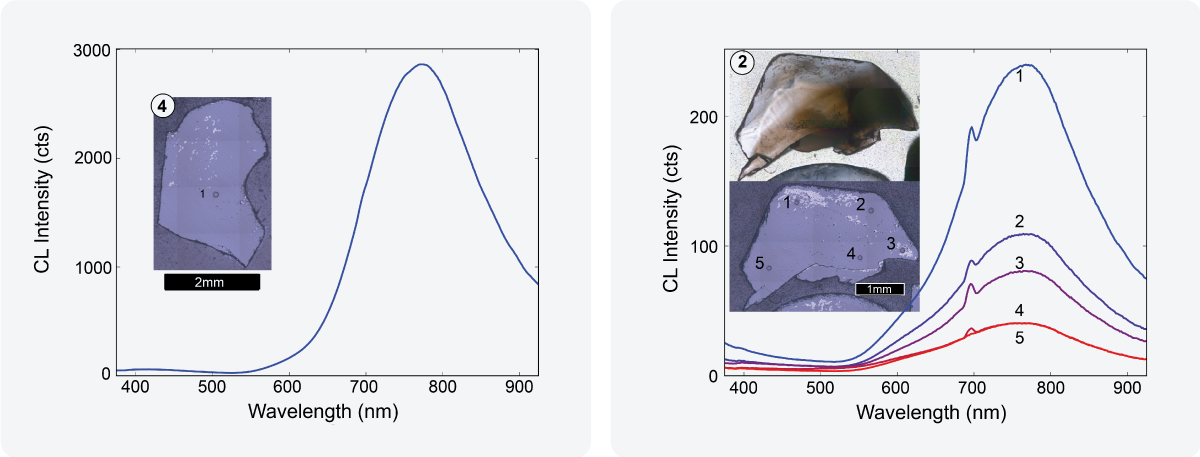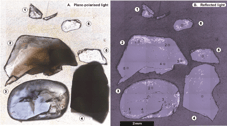Sapphire is a valuable gemstone that typically forms in metamorphic or igneous rocks deep within the Earth’s crust. The growth of sapphires, which are made up of O2- anions and Al3+ cations, is a slow process that requires rocks rich in aluminum (Al) and oxygen (O) and depleted in silicon (Si). Structural geologists are particularly interested in geological processes that result in such environments and can gain insights into these processes by studying sapphires.
A common feature of sapphires is color zonation, and a deeper understanding of this phenomenon could offer crucial insights into the crystallization history and formation conditions.
The color of a sapphire is determined by trace amounts of elements substituting Al3+. Sapphires are commonly blue due to charge transfer between Fe2+ and Ti4+. Zonation is widely researched in geology, often with the use of cathodoluminescence (CL) imaging [1]. However, there has been limited application of CL imaging on natural sapphires.
That is why Toon Coenen, Delmic’s Director of Materials Science, teamed up with Jacqueline Wong and Charles Verdel to quantitatively analyze six distinct Australian sapphires using CL imaging [2]. They used Delmic’s SPARC Spectral CL detector to detect the sapphires' CL emission and laser ablation inductively coupled plasma mass spectrometry (LA-ICP-MS) to measure local trace element concentrations.
Variations in CL emission
They found variations in CL intensity spectra between the sapphires, as well as variations within the color-zoned sapphires, depending on the location of the analysis. Using the LA-ICP-MS analysis, they could correlate these variations with the trace element compositions. The main ions that influence the CL signal in sapphires are Fe2+, Ti3+, Ti4+, and Cr3+.
For instance, an opaque-dark sapphire showed a peak at ~775 nm, which generally relates to Ti3+ substitutions. Another color-zoned sapphire showed CL spectra of five different spots with a similar broad peak at ~775 nm and a narrow peak at ~694 nm, the latter of which corresponds to the presence of Cr3+ (Figure 1).

Figure 1: CL spectra of a single-color opaque-dark sapphire and a zoned sapphire. The opaque-dark sapphire shows a peak at ~775 nm, which generally relates to Ti3+ substitutions. The color-zoned sapphire shows CL spectra of five different spots with a similar broad peak at ~775 nm and a narrow peak at ~694 nm, the latter of which corresponds to the presence of Cr3+. Taken from [2].
The trace elements Fe and Ti were found in the highest concentration and were found to be responsible for variations in CL emission. Therefore, the researchers focused on these ions for further analysis. They found a positive correlation between the CL emission and Ti concentrations, as well as a negative correlation between CL emission and Fe emission.
Furthermore, the presence of Fe2+, Ti3+, and Ti4+ is correlated. When the ratio of Fe/Ti is low, Ti3+ is the dominant form. Then, when Fe/Ti increases, the ratio Ti4+/Ti3+ increases as well. This correlation might reflect the reducing and oxidizing conditions during sapphire formation.
This is the first study that touches upon the correlation between Fe and Ti in natural sapphires. Read more on the methods, findings, and implications of this research in the white paper below!
References
[1] Götze, J. et al., Microscopy and Microanalysis 18, 6, 1270–1284 (2012)
[2] Delmic White Paper 'Complementary Cathodoluminescence and Mass Spectrometry of Australian Sapphires'
.png)









